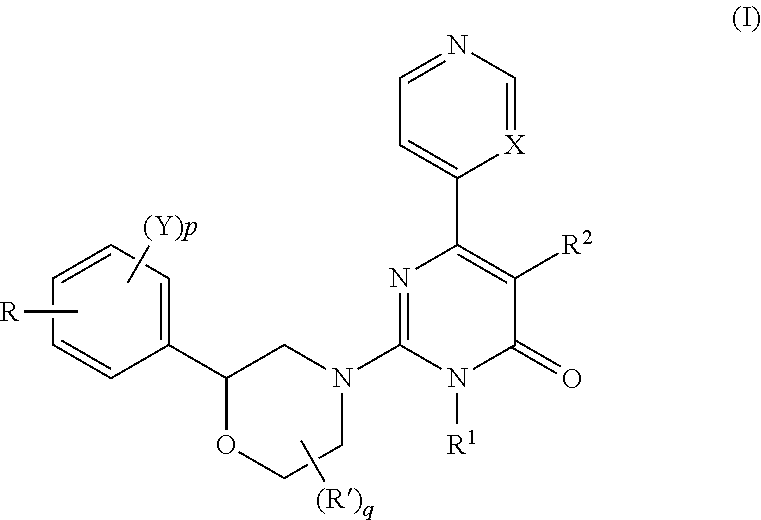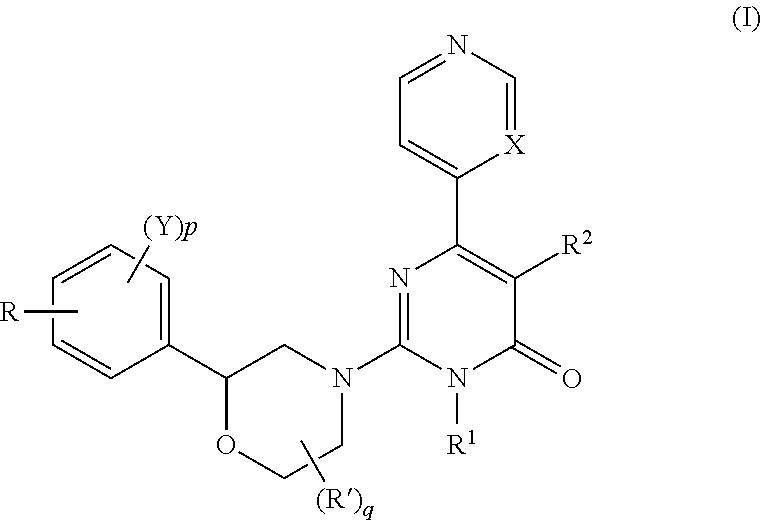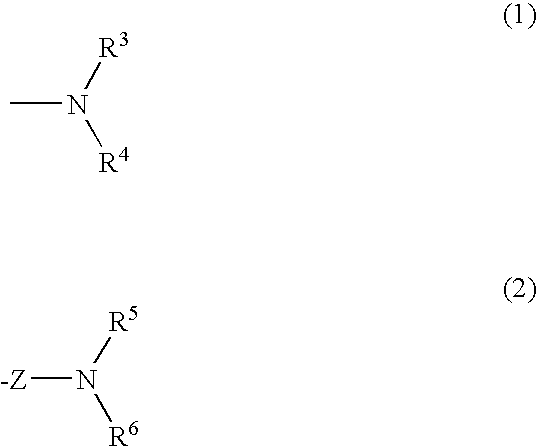2-morpholino-4-pyrimidone compound
a technology of pyrimidone and morpholinol, which is applied in the field of 2morpholino4pyrimidone compound, can solve the problems of unelucidated disease, serious social problems of disease, and increased patient numbers, and achieve the effect of suppressing the neurotoxicity of a and inhibiting the death of nerve cells
- Summary
- Abstract
- Description
- Claims
- Application Information
AI Technical Summary
Benefits of technology
Problems solved by technology
Method used
Image
Examples
example 1
N-(4-((2S)-4-(1-Methyl-6-oxo-4-(pyridin-4-yl)-1,6-dihydropyrimidin-2-yl)-morpholin-2-yl)phenyl)acetamide (Compound No. 39)
2-bromo-(1S)-1-(4-bromophenyl)ethanol
[0462]A borane-tetrahydrofuran complex (1.0 M solution in tetrahydrofuran, 270 ml, 270 mmol) was added to the solution of (S)-CBS ((S)-2-Methyl-CBS-oxazaborolidine, 50 ml, 1.0M solution in toluene) at −30° C. over 15 min and the solution was stirred for 15 minutes. 4-Bromophenacyl bromide (75.0 g, 270 mmol) in dichloromethane (350 ml) was dropped over 70 minutes keeping the temperature −32 to −28° C. After one hour stirring, solution was warmed to room temperature, and methanol (10 ml) was added slowly and then 0.5 M hydrochloric acid (300 ml) was dropped over 10 minutes. The solution was filtered after 40 minutes stirring and filtrate was extracted by dichloromethane. The combined organic layer was washed with 0.5 M hydrochloric acid, 0.1M aqueous sodium hydroxide and brine and dried over anhydrous sodium sulfate. Concentrati...
example 2
N-(4-((2S)-4-(1,6-Dihydro-1-methyl-6-oxo-4,4′-bipyrimidin-2-yl)-morpholin-2-yl)-phenyl)acetamide (Compound No. 40)
[0474]A solution of N-(4-((2S)-morpholin-2-yl)phenyl)acetamide (5.78 g, 26.2 mmol), 2-chloro-1,6-dihydro-1-methyl-6-oxo-4′4-bipyrimidine (4.00 g, 18 mmol), and triethylamine (6.00 g, 60 mmol) in tetrahydrofuran (100 ml) was stirred at 95° C. for one hour. The solvent was removed in vacuo and the residue was partitioned between water and dichloromethane. The organic layer was dried over anhydrous sodium sulfate and the solvent was evaporated under reduced pressure. The resulting residue was purified by column chromatography on silica gel (chloroform-methanol, 10:1) to afford N-(4-((2S)-4-(1,6-Dihydro-1-methyl-6-oxo-4,4′-bipyrimidin-2-yl)morpholin-2-yl)phenyl)acetamide (5.7 g, 30%) as pale yellow crystals.
example 3
(S)-2-(2-(4-(N-cyclohexyl-N-methylamino)phenyl)morpholin-4-yl)-3-methyl-6-(4-pyridyl)-pyrimidin-4-one (Compound No. 10)
(2S)-2-(4-(cyclohexylamino)phenyl)-4-((1R)-1-phenylethyl)morpholine
[0475]To a suspension of (2S)-2-(4-bromophenyl)-4-((1R)-1-phenylethyl)morpholine (7.62 g, 22.0 mmol), palladium acetate (198 mg, 0.88 mmol), 2-(di-t-butylphosphino) biphenyl (525 mg, 1.76 mmol), and sodium tert-butoxide (2.96 g, 30.8 mmol) in toluene (40 ml) was added cyclohexylamine (3.78 ml, 33.0 mmol) at room temperature. After heating at 90° C. for 2.5 hours, the resulting suspension was passed through a Celite column. The filtrate was concentrated under reduced pressure, and the residue was purified by silica gel chromatography eluting 5-25% of ethyl acetate in hexane to afford (S)-2-(4-(cyclohexyl-amino)phenyl)-4-((R)-1-phenylethyl)morpholine (6.95 g, 87%) as white crystals.
(2S)-2-(4-(N-cyclohexyl-N-methylamino)phenyl)-4-((1R)-1-phenylethyl)morpholine
[0476]To a solution of (S)-2-(4-(cyclohexyla...
PUM
| Property | Measurement | Unit |
|---|---|---|
| molecular weights | aaaaa | aaaaa |
| temperature | aaaaa | aaaaa |
| weight | aaaaa | aaaaa |
Abstract
Description
Claims
Application Information
 Login to View More
Login to View More - R&D
- Intellectual Property
- Life Sciences
- Materials
- Tech Scout
- Unparalleled Data Quality
- Higher Quality Content
- 60% Fewer Hallucinations
Browse by: Latest US Patents, China's latest patents, Technical Efficacy Thesaurus, Application Domain, Technology Topic, Popular Technical Reports.
© 2025 PatSnap. All rights reserved.Legal|Privacy policy|Modern Slavery Act Transparency Statement|Sitemap|About US| Contact US: help@patsnap.com



